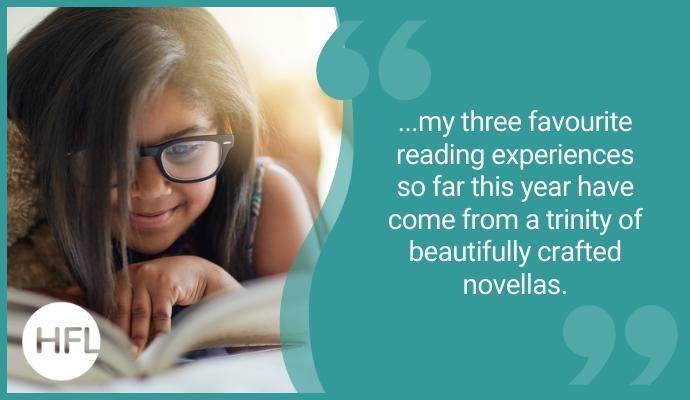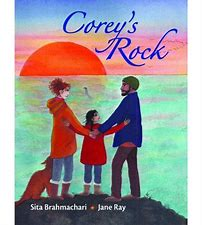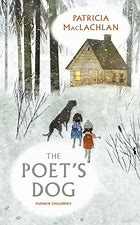
Why this blog? Why now? The main trigger for this blog is that my three favourite reading experiences so far this year have come from a trinity of beautifully crafted novellas. First came The Blue Book of Nebo by Manon Stefan Ros, an English translation from the original Welsh, and suitable for YA+ readers. I have to thank Jo Bowers, Reviews Editor for Just Imagine for this very welcome recommendation. Then, also thanks to Jo, came Katya Balen’s Birdsong. I won’t get into how special that book is here, I wax lyrical in this review for Just Imagine: Birdsong — Just Imagine. Finally, in late summer, came a more grown up read: Claire Keegan’s Foster. This novella is expanded from the original short story published by the New Yorker. It’s so deeply good that I urge you to read it. A profoundly human book. Not for the first time, I have Mary Roche to thank for a brilliant recommendation. Forgive me if draw on a cliché: each of the above was small and perfectly formed. I thought why not a new “small is beautiful when it comes to reading” kind of blog. It wouldn’t be my first.
I hope you don’t mind if I briefly rewind back to January 2021 and this blog on the power of short stories in the primary classroom. In that blog, I made a case for including a rich seam of short stories as part of the reading journey our children make through the primary phases. I want to now extend that argument for the inclusion of novellas, or shorter novels. I’ll provide some further rationale and then a range of recommendations that span the phases. Before I do, I just want to repeat some of the most pertinent points made in that blog. I go into the topic in greater depth there. In short though, the following points make a fair stab of distilling those earlier arguments:
- the time constraints of terms and timetables – incorporating shorter reads varies the rhythms of the reading year. Please don’t think this comes at the expense of longer reads; my suggestions are complementary
- the satisfaction of experiencing, together, a complete narrative within a reasonably short space of time – pretty much all of the suggestions below could be comfortably read aloud in the space of one or two weeks. In the earlier blog on short stories I expand on this notion of completeness (or perfection if we can briefly get a bit Latinate). I’m backed up there by no-less than Graham Greene in making that case. Go and check out his pearls of wisdom
- bringing shorter reads into the reading diet extends the scope for increasing the range and diversity of voices and perspectives shared across the year – this has social and reading-into-writing benefits
- shorter fiction, much like poetry, when done well tends can often make each word and line of prose seem to count for more

I’ve been meaning to write a blog along these lines for some time now, ever since reading the very special Corey’s Rock, a collaboration between Sita Brahmachari & Jane Ray. That pairing alone should be sufficient reason for getting hold of the book. It’s beautiful across line, length, and image and perhaps most especially in how those words and images interplay. If you do need further persuasion, you could always read this review that I wrote for Just Imagine. As I say, it’s a very special book. I would explore it with classes from year 4 upwards – not because the content is necessarily unsuitable for younger children, but some of the nuance and interplay of word and image might be most fully appreciated by older children.

Since then, I’ve enjoyed a rich range of novellas both suitable for children to read, and suitable for reading aloud to children. Favourites include The Poet’s Dog by MacLachlan; The Runaways by Ulf Stark with the warm illustrations of Kitty Crowther; A Story Like the Wind by Gill Lewis, with beautiful illustrations from Jo Weaver; and the gently heart-breaking Captain Rosalie by Timothée De Fombelle, with illustrations by Isabelle Arsenault. Each have offered rich reading and some wonderful opportunities for further supporting deep thoughtfulness and complex discussion.
One of the most interesting set of lessons came from a (very) slow read of the first few pages of Story Like the Wind. Quite simply, this teaching sequence involved pausing at the end of each section across the opening pages and - much like an approach suggested by George Saunders in his wonderful exploration of Russian short stories, A swim in a Pond in in the Rain – allowing time to discuss the developing story. I asked children to tell me what they knew as more and more was revealed and the situation and characters took shape. Each page requires plenty of mental joinery. There is much scope to be misdirected, requiring the reader to recalibrate as they move from section to section. Picking our way carefully through such an artfully constructed book offered a hyper-rich chance to carry out some very deep thinking as meanings unfolded. A Story Like the Wind also shares another key strength with all of the books mentioned so far: rich characterisation and interplay between characters that goes well beyond surface level detail or simple plot mechanics. I can’t afford to branch off into a significant and substantial tangent, but this quality of richness in relation to the lives presented in the book is vitally important in developing empathetic readers – and that matters more than we sometimes realise. It matters so much more. If you would like to know more on the cognitive and social benefits of working with high quality books that support or develop empathy, you might like to listen to this podcast that I recorded with my colleague Marie-Clare Kelly.
To wrap up, I’ve gathered together a relatively condensed list of some of my favourite shorter reads over the past decade or so. In keeping with the themes of this blog, time was short when I was putting this together and so it is a short list as it stands.
It’s very far from complete – there will be classic and more recent titles missed out altogether. We’d love to hear your recommendations so do please share them with us on Twitter @HertsEnglish.
Well, for now at least that’s me signing off. It’s been quite a journey since my then-colleague Rachel Rayner and I first suggested we begin blogging as an organisation. I’ll miss contributing but I shall certainly look forward to reading more of the team’s output. Thanks for reading and long may it continue.


